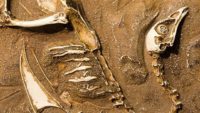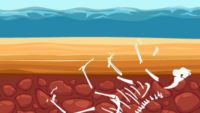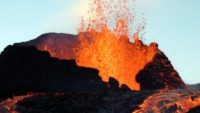Scientific experiments confirm that dead crocodiles need to be buried quickly in sediment to fossilize. Read More
According to modern sedimentation rates, are there enough sedimentary rocks to span the millions of years of ‘geologic time’? Read More
By Harry F. Sanders, III Ichthyosaurus is well studied, and research on their skeletons has provided evidence for incredible design and the global flood. …read more Source: AIG Daily
By Tim Chaffey Are dinosaurs proof of millions of years of evolution? Or a reminder of God’s glory? …read more Source: AIG Daily
Do these skulls prove common ancestry between apes and humans? Read More
By Harry F. Sanders, III Fossils are often found where they are not expected, and these finds cause evolutionists to frequently revise their timelines. …read more Source: AIG Daily
Unusually deep evaporite deposits underneath the Mediterranean have some scientists scratching their heads-but there is a biblical answer to the mystery. …read more Source: creation.com
Secular scientists recently determined that most of the dinosaur fossils in the Morrison Formation were buried quicker than commonly thought.1 The Morrison Formation is famous for its compositional consistency and massive extent across the American West, covering nearly 700,000 square miles, and for its rich dinosaur quarries. The Morrison Formation is remarkable for its dinosaur fossils an… More… …read more Source: icr.org
By Dr. Andrew A. Snelling Forming the coveted qualities of jade requires unique conditions unlike anything on earth today. …read more Source: AIG Daily
Could feathered dinosaurs have existed? Logically distinct question: did dinosaurs evolve into birds? Read More
Massive coastal sand dunes were most likely formed both before the post Flood Ice Age, and immediately after the post Flood Ice Age. Read More
Ever seen sedimentary rock layers in cliffs? They were deposited in rapid water currents, sideways Read More
In 2015, schoolteacher and amateur fossil hunter Philip Mullaly discovered a number of three-inch teeth of what would later be classified as the large Great Jagged Narrow-Toothed shark (Carcharocles angustidens).1 The teeth were found along a beach in Victoria, Australia. A three-inch tooth would have come from a shark in the neighborhood of 25 feet long—longer than the biggest recorded Great White. … More… …read more Source: icr.org
The recent Alaskan discovery of an unusual assemblage of footprints in Cretaceous rocks has paleontologists scratching their heads. Anthony Fiorillo, of the Perot Museum of Nature and Science and his co-authors, reported the trackway discovery in Scientific Reports.1 The numerous footprints were found in Denali National Park in central Alaska in the Cretaceous Lower Cantwell Formation. &nbs… More… …read more Source: icr.org
How do creationists explain them? …read more Source: creation.com
By Ken Ham The evidence for the global flood is all around us—the rocks cry out their testimony to the truth of God’s Word. Sadly at most of the sites of these great testimonies to the flood and its aftermath, the signage refuses to acknowledge how this catastrophe and its aftermath shaped geology. Instead they appeal to slow, gradual processes over millions of years to explain various geological features. But when you reject the greatest catastrophe off all time, you won’t come to the right interpretation of the evidence! We encourage people to view natural wonders such as the Grand [More]
The discovery of a new fossil in northwest China sent shockwaves rippling through the secular paleontological world. The new sauropod (longneck) dinosaur called Lingwulong shenqi, or “amazing dragon from Lingwu” was excavated from an area and a sedimentary layer that secular science believed was both the wrong geological place and time for that fossil.1 Xing Xu, from the Chinese Academy… More… …read more Source: icr.org
By Ken Ham Evolutionary scientists have recently announced the “surprising discovery” of a dinosaur similar to Diplodocus (one of the long-necked dinosaurs) in a region of northwest China where these dinosaurs were not believed to have lived, fifteen million years earlier than scientists thought they had evolved. This discovery now “forces a complete re-evaluation of the origins and evolution of these animals.” When I point out that the evolutionary story and timeline have been revised again many evolutionists will quickly declare, “that’s science! The process of science changes our knowledge as we discover more evidence and data.” But what’s wrong [More]
Two recent news stories, one from the Carnegie Institute for Science1 and another from an issue of Nuclear Technology,2 shed light on an icon of “deep time” radioisotope dating—the Isochron model. The former reported evidence that quartz crystals in samples of a granite body can crystallize at temperatures below what has been conventional orthodoxy in the geochronology field for years. The la… More… …read more Source: icr.org
The Sahara Desert was once well-watered. How did it become a desert?
By Ken Ham Tour most museums or open almost all geology textbooks, and you’ll see fossils presented through one lens: they were deposited slowly and gradually over millions of years. But there’s an entirely different way of looking at fossils that actually explains what we observe—the global flood of Noah’s day. In a biblical worldview, fossils are not the result of millions of years of slow and gradual processes. Most were rapidly buried during the yearlong flood. This rapid, catastrophic burial explains the geological features we see: Preservation of soft parts and creatures like jellyfish that have no hard parts. [More]
After nearly sixty years of misinterpreting these bones from ‘human prehistory’, how could paleontologists have gotten it so wrong? …read more Source: creation.com
By Ken Ham When you hear about fossils, it’s generally within the context of hundreds of thousands or millions of years. Indeed, a recent news article on lab-made fossils began with “fossils are certainly fascinating, but [they] do take rather a long time to form.” It later adds, “over the course of anywhere from tens of thousands to millions of years…the bones [turn] to stone.” But what did the lab-made fossils really demonstrate? They showed it doesn’t take millions of years to form fossils! Scientists were able to make fossils from fresh specimens in just 24 hours—one day! All it [More]
In the U.S. Gulf Coast region, the Upper Jurassic Norphlet Sandstone rests right on top of thousands of feet of Middle Jurassic salt, known as the Louann Salt. Secular geologists believe this sandstone layer was deposited by the windblown accumulation of sand in an arid environment. These kinds of deposits are commonly called aeolian deposits.1 Secular scientists never address or explain exactly how this cl… More… …read more Source: icr.org
By Avery Foley If there really was a global flood as described in Genesis, what would we expect to see today? Where are all the fossils of pre-flood humans? …read more Source: AIG Daily
By Dr. Andrew A. Snelling The visitor overlooks at Bryce Canyon, Utah, provide a breathtaking spectacle of row upon row of towering columns. …read more Source: AIG Daily
By Michael J. Oard Sometimes nature gives us a glimpse at the possibilities during the flood. Such a glimpse was provided by a recent ice storm on the mountains of Hawaii. …read more Source: AIG Daily






































